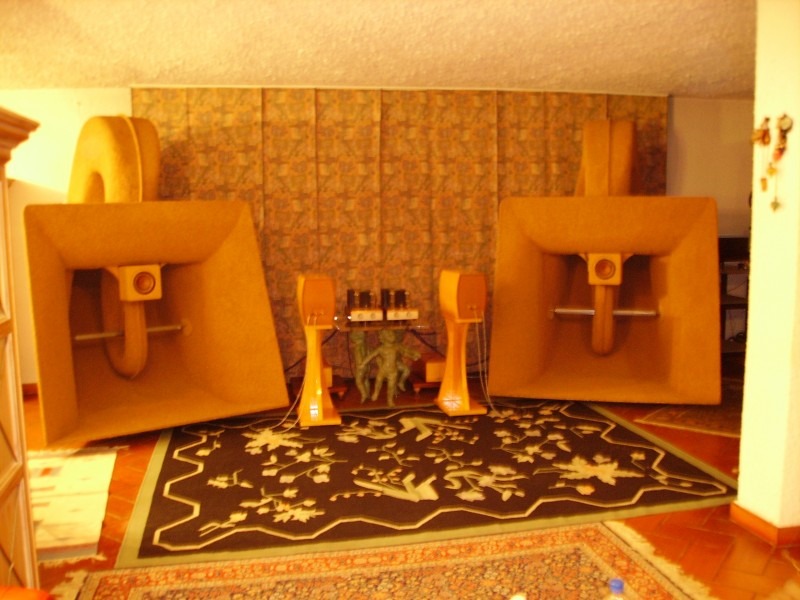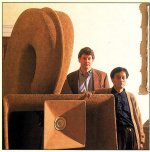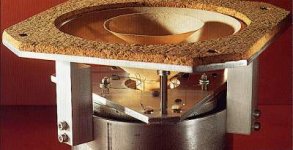Back in 1996 Be Yamamura and Robert Churchill introduced to the UK, a range of full range bicone speakers driven by current source amplifiers. Very stylish products, even their retail studio was located in a wing of a castle!
Their Dionisio 27 was listed for 25000 UK pounds ex VAT back then! Gallery stuff.
Mr Pass did you ever have a chance to listen to those products?
Having read an interview by Be Yamamura at the time your new stuff and findings brought a Deja Vu feeling.
Their Dionisio 27 was listed for 25000 UK pounds ex VAT back then! Gallery stuff.
Mr Pass did you ever have a chance to listen to those products?
Having read an interview by Be Yamamura at the time your new stuff and findings brought a Deja Vu feeling.
Attachments
No, they forgot to send me a pair.
I was under the impression that the amps were tubes, but
haven't gathered any more info that except the photos. When
it came time to revamp the Claw, the Yamamura shape was an
inspiration. Of course I had to make it bigger, if less elegant.
😎
I was under the impression that the amps were tubes, but
haven't gathered any more info that except the photos. When
it came time to revamp the Claw, the Yamamura shape was an
inspiration. Of course I had to make it bigger, if less elegant.
😎
Mr Yamamura used to make excellent tube amps but in that interview he actually said that when it comes to drive a single loudspeaker unit at a certain impedance the 'trans-impedance' amplifier is a world apart. He also maintained the importance of excellent resistor component quality for such amps. He certainly converted to current source amps since those findings. His amp products could burst into flames if illtreated though due to lack of protection circuits!
No, the amps are SS not tubes, high current, single power pack sanken (if i remember well).
I own both (amps and speakers)
They have changed the Cantus speaker and the mouth of the Dionisio (now it is bigger) as you can see in this pic. 🙂

Pietro
I own both (amps and speakers)
They have changed the Cantus speaker and the mouth of the Dionisio (now it is bigger) as you can see in this pic. 🙂

Pietro
the 'trans-impedance' amplifier is a world apart....=He certainly converted to current source amps since those findings.=
trans-impedance amplifier = current source amp
dave
Pietro, Dave, in post 3 I meant that he preferred the SS current source amp and that is what he made.
Pietro, I am quite curious to see the paper fibre structure of the Yamamura cones. Could you post some images taken at short distance? Thanks in advance!I own both (amps and speakers)
Best regards,
Peter
I visited Robert and Be and listened to the system in the castle. Actually the speakers where setup in a very big room. I think they where 14m apart. Quite surreal.
I had made that question to Nelson in 2004 after I saw his then new big folded horn for little FR speakers driven by his F current source amps. He had saw the Yamamura shapes but never in true life. So you are the one to tell us more after zombie thread walks again six years later. Could you listen any good in that place? Had echo treatments?
It was a total Yamamura system with turntable and all. Actually Be and Robert liked to listen to really old Jazz and Clasical partly in mono and very poorly recorded mostly. It stired up a lot of emotions in me but i can not say that it was particular low in couloration. Be had the habit to change all the time and actually one of his coworkers build a transmission line speaker right away especially for me and later the evening they got it playing. The soundstage from that big cork horn was very unusual. Very wide and deep but not especially well focussed. I have to admit that i liked Be´s theoretical creativity more then the results he got but maybe i simply was not prepared enough to apreciate the system more. Nevertheless he was a great teacher and a big influence for me.
Talking about acoustics, the system was setup in a huge long and high room in a wing of the castle. There where some expensive antique furniture and a lot of big nice oil paintings of roberts wife but there was no acoustic treatment that i was aware of, maybe some carpentry.
Edit: Thanks for the historic account Joachim. You already answered the room acoustics question too.
Be had a lot of ideas to make a better suspension and this one is really nice. Jordan used tangential berillum copper wires in the old days so this is in some way not a new idea. Old Klangfilm had Bakelite suspensions and Hartley still uses something similar with glassfiber.
Those of you who attended the last Burning Amp Festival in
San Francisco will remember a pair of solid state Yamamura
amplifiers on display. I was returning them to Joe Cohen of
Lotus (the former Yamamura distributor and current Feastrex
distributor). They did indeed use the Sanken amplifier chips.
😎
San Francisco will remember a pair of solid state Yamamura
amplifiers on display. I was returning them to Joe Cohen of
Lotus (the former Yamamura distributor and current Feastrex
distributor). They did indeed use the Sanken amplifier chips.
😎
Hi Peter,Pietro, I am quite curious to see the paper fibre structure of the Yamamura cones. Could you post some images taken at short distance? Thanks in advance!
Best regards,
Peter
you can see some pics made at my house at this link.
Ho visto un re!
If the images of the Cantus speaker taken at short distance are not good enough (i own the speaker you see as new spare part in case of problem to a speaker, but the little cone is not till on it), i can try to make some new ones and post them in few days (i am not at home actually).
🙂
Pietro
Pietro, Dave, in post 3 I meant that he preferred the SS current source amp and that is what he made.
Yes, 🙂
i did understand this, my answer was for Mr. Pass who spoke of tubes.
Pietro
Last edited:
I visited Robert and Be and listened to the system in the castle. Actually the speakers where setup in a very big room. I think they where 14m apart. Quite surreal.
When i bought the speakers, i visited too their headquarter in Tilsbury.
The room was large but not deep with marble floor, and acoustic problems, the speakers were completely lateral like a big headphone to try to increase high frequencies listening.
The turntable was not working (as they never produce the phono riaa preamp) and we listened to thir CDP (a TEAC modified by Be).
But at that time they ( Be and Robert) had the first version of the Cantus speaker that was white paper made and was really without high and low frequencies i felt (it existed in 2 dimensions, 150 mm and 200 mm) at the caste they produced just the cables and the ciabatta, speakers and elecronics were made in Italy near Verona.
During the following years, Be, who lived in Italy not too far from me, made a lot of changements in suspensions and materials (much lighter and rigid also for carbon fiber suspensions) and arrived to the last version of the Cantus (that is made only in 150 mm).
He changed also the bearing system for both: speaker and base of Dionisio.
At that time, he came very often to my house to try and listen how the new speakers sounded on the Dionisio (as in his house, he had not the place to keep the Dionisio).
Also the mouth has changed, and the flange around the cantus disappeared from the 3rd Cantus version.
So the last Dionisio sounds really different from the first ones (and for my taste/sensibility they sound better with tubes than with the whole YC system).
🙂
Pietro
Last edited:
Only pic I could find, hope it helps
rgds
james
This is the first version of Cantus, with round carbon fiber suspension and amber glue paper (and white color).
The paper was cutted in a spyral form and glued, in following Cantus, the cone was assembled by pasting a lot of thick triangles with arc (round) base.
🙂
Pietro
Thats what i say, it was a work in progress. Very fascinating. Actually i have had e-mail contact with Be recently. He lives now in Japan in a small vilage and made what he called his final amp. I could mail him and ask if he could tell us something.
- Status
- Not open for further replies.
- Home
- Loudspeakers
- Full Range
- Yamamura

